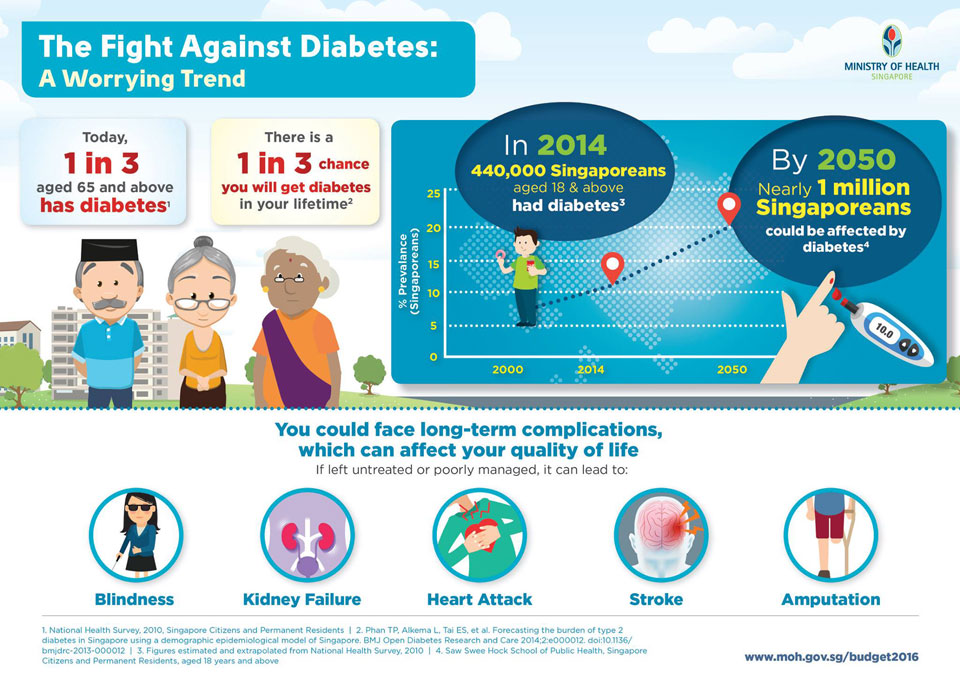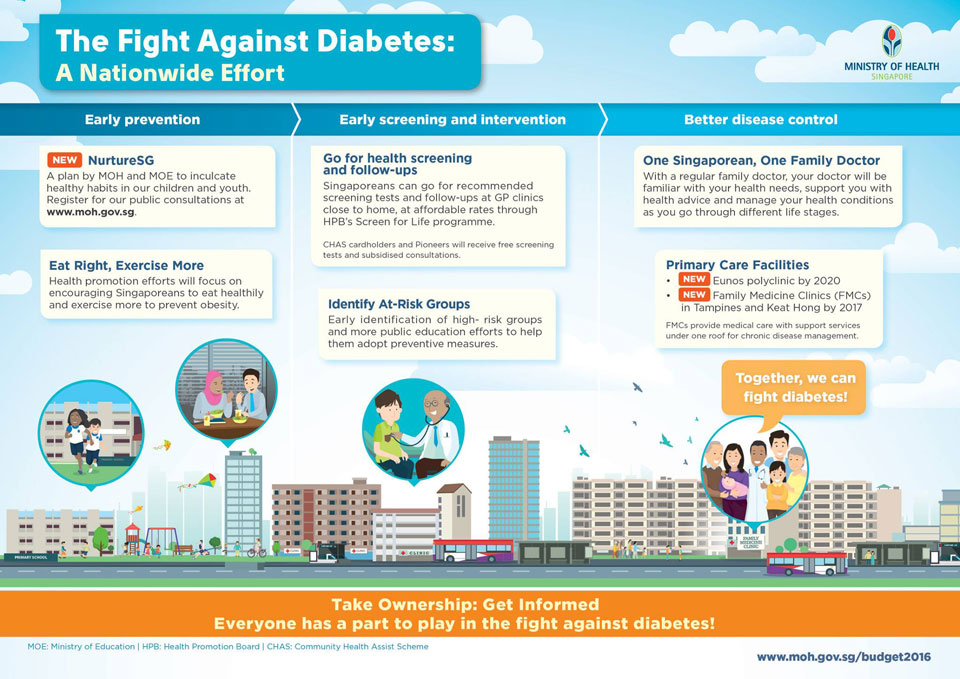When it comes to making statements about revolutions that need to be won, few nations are as resolute and focused as Singapore. So when the nation’s Ministry of Health (MOH) declared war on diabetes, the ministry had plenty of ammunition marshalled to call the public’s attention to this life-threatening disease. If you or your family have already begun to wage war on diabetes, you know that it’s a battle worth winning.
Perhaps the most vocal spokesperson on the subject of how diabetes impacts Singapore society, Health Minister Gan Kim Yong recently stated that this ailment is costing the nation more than $1 billion a year to help 400,000 diabetics of all ages who suffer from it.
Sadly, it’s estimated that one in three people don’t do what’s necessary to combat the ailment in order to live longer, healthier lives — and some haven’t even considered the fact that they may have it or refuse to have their suspicions confirmed.
To show the country’s seriousness of purpose, Mr. Gan led a heated debate in Parliament on 13 April when the subject of Singapore’s annual and projected healthcare budgets came up. Pleading for nationwide awareness, Mr. Gan wasn’t timid about recounting the consequences of undetected, untreated or poorly managed diabetes that too often results in “heart disease, stroke, kidney failure, blindness and amputations” for Singaporeans.
[su_quote cite=”Singapore Health Minister Gan Kim Yong “]We want to help Singaporeans live life free from diabetes and, for those with the disease, to help them control their condition to prevent deterioration.[/su_quote]How serious has this illness become? Every day, four citizens lose an extremity — hands, toes, feet, legs, arms — as a result of complications from diabetes, reason enough to throw down the gauntlet and declare war. And since we are always in the mood for a good battle, we’ve joined the fray and hope to use our influence to change the diabetes landscape across the land, too.

What you should know
What is diabetes? This metabolic disease strikes when the body can’t produce insulin or isn’t able to produce enough insulin to keep glucose levels in the blood stable and the body functioning properly.
At its most extreme, diabetes can lay dormant in a person’s body and show itself only once it’s reached an advanced state. Education is a valuable tool here, so learn more about this disease and you’ll be in a better position to make a determination about yourself and your loved ones.

- Type 1 Diabetes is the most serious form of the disease because it doesn’t necessarily stem from poor diet, lack of exercise and bad living habits. People are born with Type 1 diabetes and it is most often diagnosed after a child or adult experiences increased thirst, frequent urination, extreme fatigue, weight loss and/or blurred vision.
- Type 2 Diabetes can be asymptomatic and go undetected for a long while before the aforementioned symptoms present themselves. This type of diabetes is lifestyle-based and diagnosed in children and adults who are overweight, don’t exercise and abuse their bodies. While there is no cure for Type 1 diabetes, people who adopt healthy diets, exercise and lose weight have been cured of Type 2 after making lifestyle changes.
- Gestational diabetes is a less frequent, yet equally serious, type of this sickness. It presents itself as a result of hormonal changes in pregnancy and can cause troubling complications that include premature birth and babies that weigh more than average. Once the mother gives birth, gestational diabetes can go into remission and may or may not present itself with successive pregnancies over time.
Why you should take diabetes seriously
As a Singapore citizen, it’s important to know how a disease like diabetes can affect an entire nation of people dramatically. Here are facts of which you should be mindful:
- Are you aware of the fact that research shows that Asians are more at risk from diabetes than people of other races?
- Did you know that 0.35-percent of Singapore’s GDP is allocated to healthcare spending and this trend shows no sign of slowing?
- By 2050, if there’s no appreciable turnaround in the number of people being diagnosed, the nation’s cost to care for this population will jump from $1 billion in 2010 to $2.5 billion per year.
- A National University of Singapore/University of California study predicts that by 2050, every working-age diabetic in Singapore will run up $10,596 in health care costs to treat it (that figure was $7,678 in 2010).
- If no changes are made in the nation’s diabetic population, kidney failure, blindness and amputations — the most extreme manifestations of either diabetes type — are expected to increase exponentially.
- Because Singaporeans have adopted western lifestyle habits — eating unhealthy foods and avoiding exercise – if this trend isn’t reversed, diabetes has the potential to impact economic growth and employment, according to diabetes specialist Dr. Lee Chung Horn.
Contemporary weapons in the war on diabetes
Dietary changes, recommended by medical practitioners and dieticians, are the first step in caring for oneself if diabetes is diagnosed or suspected in conjunction with exercise, because in combination, they help sufferers of both Type 1 and 2 live longer, healthier lives.
Type 1 diabetes is usually treated with insulin injections, pills and new formulations of drugs on the market. Some doctors may prescribe a “pump” to administer insulin as needed through a pot in the body.
According to Healthline Networks, these are the most frequently prescribed medications for diabetes at present:
- Short-acting meds like Humulin and Novolin,
- Rapid-acting insulins like NovoLog, FlexPen, Apidra and Humalog,
- Intermediate-acting drugs like Humulin, Novolin and Iletin,
- Long-lasting formulas like Levemir and Lantus.
Each must be taken in specific doses and depending on the severity of the diabetes, may be increased, decreased or prescribed in combination.
[su_pullquote align=”right”]The war on diabetes will not be a quick battle, but a long war requiring sustained efforts.[/su_pullquote]While medicines help combat this disease, diet is critical to manage both types of diabetes. The American Diabetes Association recommends a balanced diet of vegetables, whole grains, fruits, lean meats, poultry, fish, some dairy products and fats.
According to WebMD, the worst choices a diabetic can make include processed foods, sugary cereals, too much fat and canned foods (excess sodium).
Diabetics should avoid deep-fried foods and stick to non-fat dairy products. Energy drinks, coffees, sweetened teas, beer, spirits and soft drinks can exacerbate symptoms and require moderation.
Central to any diabetic’s regular routine is the addition of exercise. While we believe that running can be the best form of exercise, all sorts of activities help the body deal with this malady, particularly since the reason extremities are at risk of amputation is so often the result of poor circulation that comes about when people with diabetes diagnoses lead sedentary lifestyles.
How we plan to help
As a publication with a faithful and loyal following of runners and athletes, we hereby commit to doing everything we can to inform, educate and help our readers understand and deal with all aspects of diabetes.
It is our intention to shine a spotlight on those who are leading the advance on the disease, from the new Diabetes Prevention and Care Taskforce under Acting Education Minister Ng Chee Meng to organizations in need of our help promoting healthy lifestyles as a way to combat and fight on the home front.

We agree with Mr. Gan when he states that, “The war on diabetes will not be a quick battle, but a long war requiring sustained efforts.” Our efforts to promote healthy lifestyles will increase, as we encourage people to lose weight through running, cross-training and diet.
As always, we continue to advocate on behalf of the nation’s efforts to curb smoking rates, since this too can contribute to one’s risk of diabetes.
Further, we plan to keep reminding readers of the importance of early screening and intervention since better outcomes are found after early detection, particularly as this impacts a major portion of our audience, ages 20 to 39.
Is this war? You bet. But sometimes, it takes a war to raise awareness about what really matters in life, so count on us to soldier on in every way we can to be a player on this important stage!
Toward that end, we hope to profile successful diabetics who have taken control over their disease as a result of making healthy diet and exercise changes.
How can you help us wage war on diabetes? Do you know of an athlete with diabetes whose story can be shared with everyone?
[su_animate type=”tada” duration=”1.5″]Want to join the war against diabetes too? Why not pledge yourself to be more healthy and active by participating in one running event monthly?Use our beautiful and most up-to-date running calendar to assist you!
[/su_animate]



